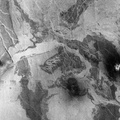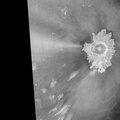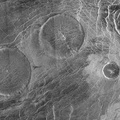![This Magellan image mosaic shows the largest (275 kilometers in diameter [170 miles]) impact crater known to exist on Venus at this point in the Magellan mission. The crater is located north of Aphrodite Terra and east of Eistla Regio at latitude 12.5 degrees north and longitude 57.4 degrees east, and was imaged during Magellan orbit 804 on November 12, 1990. The Magellan science team has proposed to name this crater Mead, after Margaret Mead, the American Anthropologist (1901- 1978). All Magellan-based names of features on Venus are, of course, only proposed until final approval is given by the International Astronomical Union-Commission on Planetary Nomenclature. Mead is classified as a multi-ring crater with its innermost, concentric scarp being interpreted as the rim of the original crater cavity. No inner peak-ring of mountain massifs is observed on Mead. The presence of hummocky, radar-bright crater ejecta crossing the radar-dark floor terrace and adjacent outer rim scarp suggests that the floor terrace is probably a giant rotated block that is concentric to, but lies outside of, the original crater cavity. The flat, somewhat brighter inner floor of Mead is interpreted to result from considerable infilling of the original crater cavity by impact melt and/or by volcanic lavas. To the southeast of the crater rim, emplacement of hummocky ejecta appears to have been impeded by the topography of preexisting ridges, thus suggesting a very low ground-hugging mode of deposition for this material. Radar illumination on this and all other Magellan image products is from the left to the right in the scene. PIA00148.jpg](i.php?/upload/2024/01/16/20240116234549-f565da7b-me.jpg)
WIKIARCHIVES.SPACE
The Human Spaceflight Archive
![This Magellan image mosaic shows the largest (275 kilometers in diameter [170 miles]) impact crater known to exist on Venus at this point in the Magellan mission. The crater is located north of Aphrodite Terra and east of Eistla Regio at latitude 12.5 degrees north and longitude 57.4 degrees east, and was imaged during Magellan orbit 804 on November 12, 1990. The Magellan science team has proposed to name this crater Mead, after Margaret Mead, the American Anthropologist (1901- 1978). All Magellan-based names of features on Venus are, of course, only proposed until final approval is given by the International Astronomical Union-Commission on Planetary Nomenclature. Mead is classified as a multi-ring crater with its innermost, concentric scarp being interpreted as the rim of the original crater cavity. No inner peak-ring of mountain massifs is observed on Mead. The presence of hummocky, radar-bright crater ejecta crossing the radar-dark floor terrace and adjacent outer rim scarp suggests that the floor terrace is probably a giant rotated block that is concentric to, but lies outside of, the original crater cavity. The flat, somewhat brighter inner floor of Mead is interpreted to result from considerable infilling of the original crater cavity by impact melt and/or by volcanic lavas. To the southeast of the crater rim, emplacement of hummocky ejecta appears to have been impeded by the topography of preexisting ridges, thus suggesting a very low ground-hugging mode of deposition for this material. Radar illumination on this and all other Magellan image products is from the left to the right in the scene. PIA00148.jpg](i.php?/upload/2024/01/16/20240116234549-f565da7b-me.jpg)
Information
- Taken in
- Author
- NASA/JPL-Caltech
- Description
- This Magellan image mosaic shows the largest (275 kilometers in diameter [170 miles]) impact crater known to exist on Venus at this point in the Magellan mission. The crater is located north of Aphrodite Terra and east of Eistla Regio at latitude 12.5 degrees north and longitude 57.4 degrees east, and was imaged during Magellan orbit 804 on November 12, 1990. The Magellan science team has proposed to name this crater Mead, after Margaret Mead, the American Anthropologist (1901- 1978). All Magellan-based names of features on Venus are, of course, only proposed until final approval is given by the International Astronomical Union-Commission on Planetary Nomenclature. Mead is classified as a multi-ring crater with its innermost, concentric scarp being interpreted as the rim of the original crater cavity. No inner peak-ring of mountain massifs is observed on Mead. The presence of hummocky, radar-bright crater ejecta crossing the radar-dark floor terrace and adjacent outer rim scarp suggests that the floor terrace is probably a giant rotated block that is concentric to, but lies outside of, the original crater cavity. The flat, somewhat brighter inner floor of Mead is interpreted to result from considerable infilling of the original crater cavity by impact melt and/or by volcanic lavas. To the southeast of the crater rim, emplacement of hummocky ejecta appears to have been impeded by the topography of preexisting ridges, thus suggesting a very low ground-hugging mode of deposition for this material. Radar illumination on this and all other Magellan image products is from the left to the right in the scene.
- Created on
- Wednesday 7 February 1996
- Albums
- US SPACE PROGRAM / PROBES / VENUS / MAGELLAN / Mission Photos (Edited)
- Source link
- https://photojournal.jpl.nasa.gov
- Visits
- 17
- Rating score
- no rate
- Rate this photo
- License
- Public Domain
- Modified by WikiArchives
- No (original)
- Downloads
- 0
Powered by Piwigo




